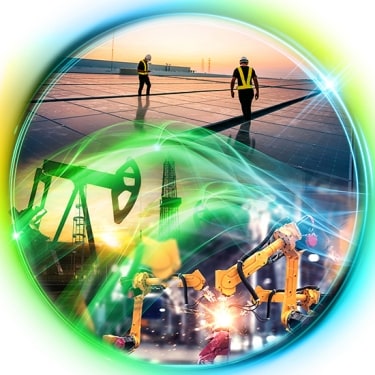Enabling the clean energy transition with next-gen advanced metering infrastructure has been saved

Article
Enabling the clean energy transition with next-gen advanced metering infrastructure
AMI 2.0 promotes decarbonization and grid resiliency
Advanced metering infrastructure (AMI) is no longer a collection of digital meters that handles a limited amount of data and a few routine tasks. AMI 2.0 is a powerful edge-computing network. Offering real-time data and more control over energy usage, next-gen AMI empower consumers, and helps utilities build a resilient grid with a reduced carbon footprint.
Why do we need the new wave of advanced metering infrastructure?
The first AMI meters were installed between 2000 and 2010, during what we are calling the “first wave.” These AMI meters and their internal batteries had a life expectancy of 20 years. As many of them approach the 20-year mark, failure rates are on the rise. Early adopters of AMI 1.0 are now planning to replace them, which can take three to five years. The next wave of meters is part of a robust technology stack, which we are calling “AMI 2.0.” Next-gen AMI consists of edge-computing devices with advanced capabilities that enable a better understanding of how electricity is used or generated—in real time. This intelligence holds a great deal of potential benefits for consumers and utilities alike. Read our full report for Deloitte’s vision of AMI 2.0 and how utilities and consumers can work together using new metering technologies to achieve decarbonization goals along with a more resilient grid.
AMI 2.0 customer benefits
With new capabilities, such as being able to communicate via Wi-Fi, meters can be paired with utility smartphone apps to provide a variety of services that do not require internet connections. For example, Salt River Project in Arizona recently allowed consumers to prepay for electricity and set thresholds via an app to control devices in their homes, giving them more control over their bills. Such capabilities not only give electric utilities additional ways to contribute to a smarter grid, but also offer residential customers far more benefits than AMI 1.0 did.
Today’s meters can make better use of disaggregation programs as well. Also known as non-intrusive load monitoring, these programs can detect the type of appliances running behind the meter based on signal processing signatures detected by artificial intelligence (AI) algorithms. The disaggregation software gives consumers a home energy management solution that can be integrated with smart home devices.
For a consumer with distributed energy resources (DER)—such as solar panels, home batteries, or electric vehicles that can discharge to the grid or use smart inverters—disaggregation software on the meter lets the customer manage the demands on DER equipment according to their preferences. Customers who participate in net metering (putting excess electricity back on to the grid) will have more information in real time about the volume of electricity being produced, allowing them to make better decisions on how much and when to store or sell energy.
AMI 2.0 utility benefits
The new meter technology has evolved at a time when grid resiliency has become a crucial issue. AMI 2.0 residential meters can capture voltage more frequently than their AMI 1.0 counterparts did. For this reason, next-gen AMI meters have extraordinary potential to contribute to grid reliability. Knowing the voltage at as many points as possible, as frequently as possible, on a utility’s distribution network can allow the operators to regulate the voltage with much more control.
Another important action utilities can take to reduce carbon emissions related to AMI 2.0 is to help consumers move to electric vehicles to reduce greenhouse gas (GHG) emissions. AMI 2.0 solves the problem of identifying the location of a high-voltage residential electric vehicle (EV) charger and determining whether or not the circuit it’s on can handle it.
To improve grid reliability when energy is fluctuating more than usual, such as during a storm or seasonal shifts in populations, utilities can perform phase detection at the endpoint of a circuit—the meters. Phase detection measures the load on a wire and a neutral wire. With AMI 2.0 meters having an accurate picture of the phase a meter is on, utilities can avoid having to send crews into the field to perform this measurement, and it means more real-time grid management (e.g., for phase load balancing).
Finally, AMI 2.0 helps “future-proof” the meter. Unlike AMI 1.0, in which memory was limited and over-the-air updates were limited to firmware, AMI 2.0 meters are like smartphones that can have new apps pushed to them as new requirements develop. Requirements that have not been incubated yet can be identified and developed into new software that can be distributed from the utility’s operations center and run as needed. Newer residential meters are simplifying solar installations by combining the capabilities of a standard meter and a net meter into a single unit.
Anticipated capabilities from AMI 2.0


Enabling the clean energy transition: Planning for the next generation advanced metering infrastructure and grid technologies
Download the full report for details on how AMI 2.0 lets utilities and consumers team up to achieve decarbonization goals along with a more resilient grid.
Get in touch
Recommendations
Energy transition: Building the framework for the future of energy
Decarbonization emerges as a primary energy transition trend
Illuminating the possibilities of Energy, Resources & Industrials
Deloitte’s Energy, Resources & Industrials specialists provide comprehensive, integrated solutions to all segments of the Oil, Gas & Chemicals, Power & Utilities, and Industrial Products & Construction sectors, including Renewable Energy, Mining & Metals, Manufacturing, and Aerospace & Defense.


